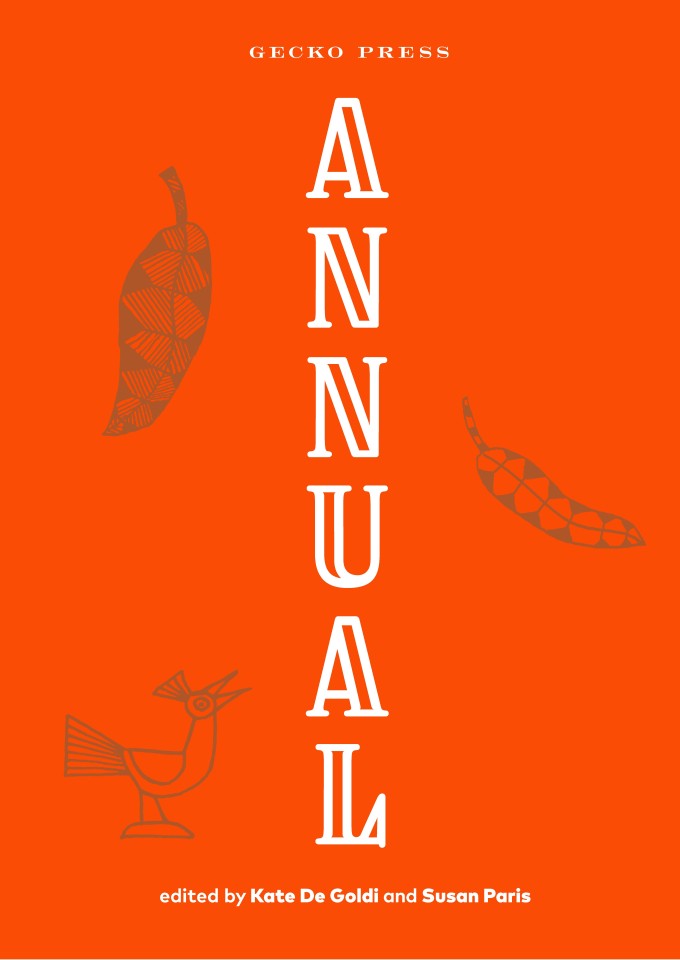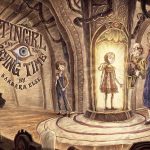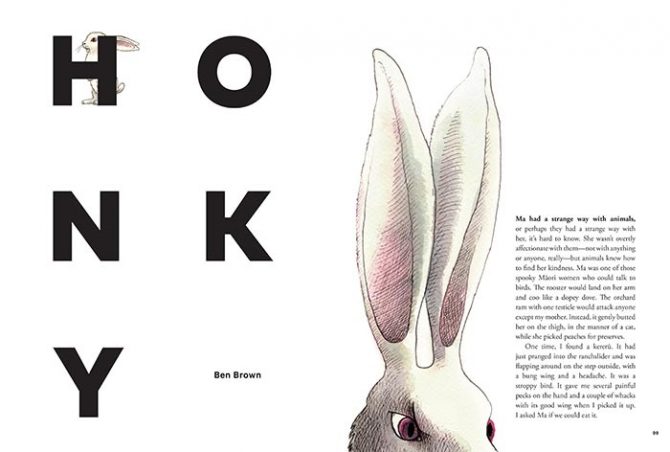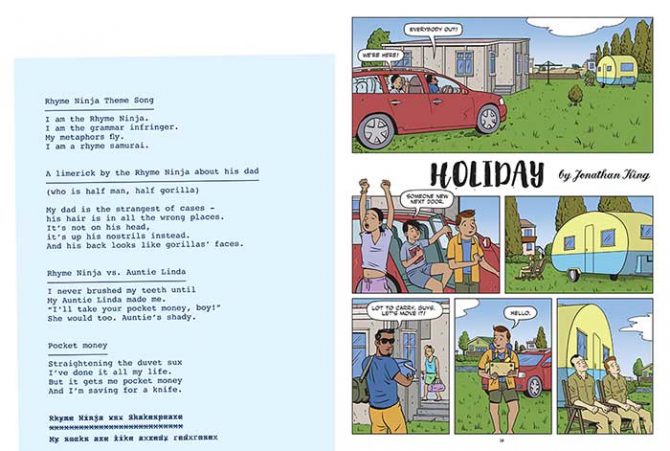We're so excited about the eagerly-awaited publication release of Annual from Gecko Press (edited by Kate De Goldi & Susan Paris). Annual is a real game-changer as the first publication of its kind in New Zealand.
Annual is a 136-page smorgasbord of stories, comics, satire, how-tos, poems, games and puzzles aimed at 9-12 year old children - and their families.
There's a dictionary of crazy words that come in handy on car trips, a sophisticated ‘spot the similarity’, a found poem from school newsletters, a maths-nerd’s memoir full of tricky logic puzzles, and top-class fiction that spans Christchurch Botanic Gardens in the 19th century, the loss of a brother, a Kiwi beach holiday and a board game.
Annual's fantastically illustrated double-spread contents page by Dylan Horrocks is a work of art in itself and the publication features a curation of specially commissioned pieces and collaborations from 41 New Zealand writers and illustrators, including: Bernard Beckett, Fifi Colston, Gavin Bishop, Dylan Horrocks, Barbara Else, Coco Solid, Samuel Scott, Whiti Hereaka, Paul Beavis, Renata Hopkins, Ben Brown, Sharon Murdoch, Damien Wilkins, Jonathan King and many others!
Why a New Zealand annual?
Kate De Goldi, co-editor of the Annual from Gecko Press, could see there was a “hectic” trend in children’s writing – popular books for children such as those that are slapstick or fantastical or series titles (think Diary of a Wimpy Kid, Captain Underpants). She says that while these books are great, the current market does not run in the favour of more nuanced, complex books.
Inspired by, and harking back to memories of children’s annuals in the UK like Bunty The Books for Girls, De Goldi reminisces that “Annuals were like Mary Poppins' carpet bag – you always see something new every time you opened one.”
Annuals were full of literary miscellany – a home for practitioners, writes, emerging talent. Kate remembers being given annuals for Christmas and how for some children it may have been the only book they got in a year so it was something to be savoured and enjoyed all year long.
With Annual, the editors set out to "reimagine an iconic book format for today's young readers." Lorde, Taylor Swift and "selfies" are in there. Indeed one of the charms of Annual is how it manages to reference pop culture yet still feel nostalgic.
Christchurch writers, illustrators and artists showcased
Speaking of nostalgia, it's evident Kate De Goldi has a soft spot for Canterbury. Born and raised here, a Christchurch connection appears throughout Annual in various forms: From local writers such as Gavin Bishop, Ben Brown and Renata Hopkins to the street art of Christchurch in a commentary on Wongi Wilson's Whare & Whānau (2014) in Spray Can Renaissance.
Due to the CBD's rebuild, Wilson's mural, that was on the corner of Tuam and Manchester streets is barely visible now, making this snapshot of a certain time and place more poignant.
We asked Kate to tell us more about the inaugural Annual:
Kate, how did the idea for Annual came about?
For some time I'd been bothered by the fact that there seemed to be a dearth of good, original New Zealand reading material for readers between 8 to 12, the reading group that American publishers/booksellers call 'middle-grade' (between 'emerging' readers and young adult readers), roughly between 8 and 12 years. Additionally, I was sorry that there were no publications anymore for emerging writers for that age group to publish short form material.
One day a couple of years ago while I was out running round the hilly streets of Wellington and thinking about these things, it suddenly occurred to me that an Annual - a miscellany of stories, comics, poetry, articles, art, puzzles, games etc - would be a great solution to both of these issues. By the time I'd finished my run I'd thought of two people who could help make it happen - Julia Marshall, the publisher for Gecko Press and Susan Paris, the editor of the School Journal.
Why is this ‘Annual’ so significant for New Zealand?
As far as we know there's never been a New Zealand publication like this for New Zealand children. This is the first publication of new, commissioned material across a variety of forms for this age group. It's also the first publication to draw contributions from such a wide range of writers and artists - well known writers and illustrators for children, but also new writers and artists or writer/artists who usually produce work for an adult readership.
Annual is also an attempt to broaden the notion of what is allegedly 'suitable' for children. We believe that the 9-12 age group is a very sophisticated readership, one that's hungry for different kinds of reading - fiction, non-fiction, graphic material, and great art - so we've commissioned work that is varied and substantial and with real literary merit. But the editors (Susan and me) have a pretty developed sense of the absurd, too, so we wanted the Annual to have funny - even silly - contributions as well as solid stuff.
Tell us about your childhood memories of annuals?
I grew up in a house full of books, including a wide range of very good children's books. Comics were kind of frowned on, though - but I loved them... I read them at other people's houses whenever I had the chance.
All the well-known British children's comics of that post-War period (Girl's Crystal; Princess; Rupert; Beano, Bunty, to name some) also had an Annual (a kind of bumper issue of the comic) published in time for the Christmas market. As a non-comic household we tended not to get the Annuals either - except one year when, for some reason, my sister Clare got Bunty. She was 8 that year, but claims she was still reading that Bunty Annual until she was 18. I believe her - the thing I noticed about annuals was that they seemed to last forever...every time you picked up a well-thumbed, familiar annual there was somehow always something you hadn't noticed before and were very pleased to read.
When we were first thinking about our annual we knew we wanted it to be like that - a gift that kept on giving. It's roughly aimed at a 9-12 readership but we hope that those readers will keep on dipping in over the years; and we're confident there will be both younger and older readers - and adults - outside the designated age group who will enjoy many of the contributions between the covers.
How did this annual come together?
Once I had the annual idea I contacted Julia Marshall who was immediately very keen on the idea of Gecko Press publishing a miscellany of this kind (Gecko's catchphrase is 'curiously good books'). Then I contacted Susan Paris, who is a good friend, but more importantly has 12 years experience commissioning and editing the New Zealand School Journal a publication embedded in the history of children's writing and illustrating in New Zealand and which is in many ways like Annual - miscellany of varied forms, but for use in the classroom.
Susan and I began by dreaming up ideas for stories, poems, articles etc and then worked out who we thought would be the best writers and artists to work with those ideas. We needed to come up with the ideas ourselves to ensure a balance across the annual - different moods (sad, funny, silly, reflective); different settings (urban, rural); gender and cultural balance; different forms (realist, fantasy, historical etc). We worked hard to match our ideas with the right artist/ writer...for example, we liked the idea of a 'found' poem composed entirely of lines taken from school newsletters. We asked James Brown to have a go at that - we knew he was great with different poetic forms. We approached writers and artists who we knew enjoyed working within certain parameters but who could still make the piece their own.
Commissioning was just the first stage - we edited all the work for publication and worked with Gecko Press to find illustrators for many of the pieces. It was particularly interesting for me - a tyro* in this regard - to see a project of this size right through from inception to publication. Every aspect of the process was fascinating - and quite consuming...debating the best sequencing of all the contributions, debating the title and cover, the color of the cover...and more. And finally there's spreading the word ahead of publication - talking to librarians, booksellers, teachers, any prospective buyers - preparing the website to go live. (* Tyro = beginner or novice).
Kate, you say that Annual is meant to be enjoyed by 'backwards browse.' What does that mean?
This was new to me - Julia told us that people nearly always explore a book, especially a volume of mixed material, from the back to the front.
It's perfectly true. I do it myself, though I'd never noticed...and we've enjoyed watching people pick up Annual and check it out by fanning the pages from back to front. That's good from our point of view - the first piece they see, then, is Naked Grandmother, the board game which is pretty entertaining. A 'backwards browse' will find you flicking through an annual until you fall on what you want to sink yourself into.
Annual's cover is quite subtle compared to the treasure trove inside. Was that intentional?
Yes, that was intentional - the title written vertically and two lovely drawings by Gregory O'Brien...the chirping bird kind of heralding something good to come. And then there's the color - a radiant orange.
We wanted the cover to be a striking design (that's the work of Spencer Levine who also designed the interior) so that the prospective reader would be drawn to pick up Annual - and then begin the 'backwards browse' through the material between the covers - which is rich indeed, a real feast for the eye.
What is your hope for the book?
Firstly, I hope the book finds its way to the readers we had in mind when we were working on it - all those readers between 9-12 who are smart, curious and hungry for new material. I hope that readers outside that age group will check it out, too. I hope especially that it is bought by school libraries - that way Annual can reach readers who may not otherwise come across the kind of material inside.
We hope that Annual becomes an annual publication! We're working on the second volume now and hope that we can keep on producing for as long as there's an audience...We hope to keep on finding new writers and artists and giving them a platform to publish. We hope, too, that NZ writers and artists for children aspire to be published in Annual, that it builds an audience among practitioners as well as readers.
Kate, you’re very prolific. What is your next project?
Susan (Paris) and I are well launched on the commissioning of Annual 2 - which is huge fun...We meet twice a week and spend hours talking and pitching ideas to each other, refining them and working out how best and who might turn them into gold.
I'm also working on a film script of my children's novel From the cutting room of Barney Kettle - another first for me and very interesting. (Set in High Street, Barney Kettle is a homage to Christchurch pre and post-quake).
Kate De Goldi is starting work on a novel in the new year and continuing a long term non-fiction project. (Her current project is a book about children's literature bibliophile, Susan Price).
__________________
Here are some personal highlights from the book:
As a parent and children's literature buff I think this book is fantastic but what about its target audience? I road-tested Annual on my 8 year-old son and we surprised ourselves by what ultimately took our delight. Aside from the obviously humorous bits, the deeper stories tugged at us too. Here are some of our highlights:
- Honky, a story about a white pet rabbit owned by a Māori family (from Lyttelton-based writer Ben Brown) certainly generated some stimulating conversation. It led us to discuss the obvious theme of race and learn the meaning of a few new words along the way, such as ironic. And, amusingly, my son thought 'tuberculosis' was a person after reading about a girl who lived in hospital "more than two years with tuberculosis." He laughed at his newfound knowledge. All up, he was a little wiser after just 3 pages worth of a short story. Thanks Ben.
- We enjoyed thinking through the logic puzzles together in the mathematician's memoir Let Me Count the Ways by Bernard Beckett. We've now memorised the puzzles to spring some conundrums on others.
- The Naked Grandmother holiday board game at the back of Annual hits the right note for kids (note: BYODice), conceived by the editors and illustrated by cartoonist Dylan Horrocks. The aim: Get through summer trying to avoid prison (a.k.a. the holiday programme). Land on a good square and your sibling has to be your servant for the day or you get to have takeaways. And bad squares? Getting a bad haircut, dropping a phone in the toilet or a sibling reading your diary (go to the Square of Shame). Worst of all is landing on the square where you accidentally see your grandmother naked (it's Game Over then).
- In the short comic Holiday, by Jonathan King, a group of beach-going mates holidaying at a bach wonder what's up with their creepy caravan neighbours. With an elliptical 'to be continued' ending we hope to see more.
- The too-real feel of the children's bedrooms in the 'Spot the Similarity' game is a fun change-up from 'spot the difference,' although you may end up spotting similarities with the childhood detritus cluttering your rooms. There may even be a floor under it all.
- The song sheet by Samuel Scott (songwriter and composer with the Phoenix Foundation) Always on Your Phone - written from the P.O.V. a kid feeling simultaneously smug and left out in the real world while the rest of his older family members are staring at their devices, lost in the online world. FOMO is real.
- There's some spot-on made-up words in A Box of Birds such as a fuzznut - a sweet lodged into the car seats long ago - followed by toshmanship... "a mute but vicious duel with your fellow backseat passenger" that usually explodes during the road trip. Dirty tactics may include rubbing said fuzznuts in opponent's hair.
- A Wee Wait (Pablo Edmonds) - a newspaper story about a befuddled woman who is accidentally locked in a public toilet overnite - or was she?
- Every Picture Tells a Story: A Guide to Visual Storytelling by Paul Beavis will appeal to budding writers and artists, includes simple book-making instructions.
- Lost Items by James Brown - a poem made up from found phrases in school newsletters - parents and children will recognise the banal snippets with amusement.
- In B.O.N.E., the journey to the Island of Misplacia (presumably where our missing socks are), by Gavin Mouldey, is a perilous delight - whether fending off Attack'n Kraken (giant cyclopean squid) or climbing through the Caverns of Cuteness (the final resting place of discarded stuff toys).
You might need a map to find your way out of Annual - it is certainly a book to get lost in - but we better stop somewhere. Ask us about our favourite offerings in it again in a few months and it may well be different writings and art. And that's the beauty of Annual: it offers an interactive and individual reading and response with something new to discover each time.
What will YOU find when you open the Annual carpet bag?
Find out more:
- The Gecko Annual in the library catalogue
- The official Annual website
- New Zealand children's author interview with Kate De Goldi
- Five Five questions with Kate De Goldi
And if your children like Annual... try Toitoi: A Journal for Young Writers and Artists













Add a comment to: Announcing Annual – a treasure trove for Kiwi children